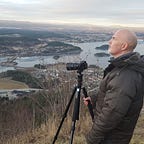Hands on with the Nisi 15mm f4
Nisi is best known for its high quality filters. The company recently changed its name to Nisi Optics pointing to that a new and extended vision is geared towards also producing quality lenses.
The Nisi 15mm f4 has been long in the making, but it is these days finally hitting the market. The lens is available in full-frame mounts for Nikon Z, Canon RF and Sony E. It also comes with Fuji APS-C X mount. For full frame cameras the lens offers a whopping 112 degree of field of view, which equals 14,5mm.
Built, handling and specifications
The built quality is very good since the lens comes with a metal chassis. Both the focus and aperture rings operate smoothly. When it is dusk it can be difficult to read the markings on the lens for someone who needs glasses for close details.
- Diameter: 79 mm
- Field of view: 111.8° (diagonally)
- Length: 77 mm
- Weight: 470g (without hood and caps)
- Filter Diameter: 72 mm
- Number of Aperture Blades: 10 (straight)
- Elements/Groups: 12/10
- Close Focusing Distance: 0.2 m
- Maximum Magnification: 1:7.7
Unlike many other wide angle lenses it is easy to attach filters to the lens since it comes with a 72mm filter thread. A close focusing distance of only 20 cm means that you can go very close to a foreground object and focus stack the scene, if you so prefer. That you are enabled to be this close to an object opens new creative possibilities.
Sharpness
The lens is very sharp in the middle of the frame and is on par with my other wide angle lenses.
Close crop of the image above:
Nisi promises that the lens delivers very good corner to corner sharpness. The next set of example images seem to confirm that claim.
Right corner:
Left corner:
Only the extreme corners go a tad soft at f9. The lens’ sweet spot is between f5.6 and f8.
Distortions
Wide angle distortions are well controlled. Horizon lines are more or less straight, and there is no middle of the frame dip in either direction. For architectural photography there is a slightly visible wave distortion.
Even lines along the edges are well preserved when shooting from a low point of view.
Usually the trees would lean towards to the middle of the frame when I shoot from such a low angle with a wide angle lens.
Sunstar
The lens produces a pleasant ten pointed sunstar at all apertures. The only thing you will notice when turning the aperture ring is that the angle of the sunstar is changing. In practical terms this means that you do not have shoot extra exposures at a narrow aperture to get a crisp and well defined sunstar.
Flare
The lens only weak spot is flare resistance. It is not uncommon for wide angle lenses to produce flare when you shoot directly into the sun. However, the Nisi is prone to a little more flare than what I am used to from wide angle lenses. It can therefore be necessary to shoot an extra exposure with a finger in front of the sun.
In this instance, however, the lens produced a modest level of flare:
Chromatic aberrations
Color fringing around high contrast edges is reasonably well controlled.
There is some modest greenish/cyan color fringing, but it vanishes immediately you check for ‘Remove chromatic aberration’ in Lightroom.
Conclusion
The Nisi 15mm f4 is a lens it is easy to fall in love with. It has character — a quality it is difficult to articulate, but which you sort of sense. The lens is lightweight and well built, and its only minor flaw is flare resistance. It may be that using the lens hood will reduce flare, but I haven’t yet tested that.
Hopefully the next iteration of the lens will come with electronic focus and aperture control. The latter will make it easier to set the desired aperture when it is dusk. I would also love to see the lens with f2.8 something that would turn it into a decent option for night photography. However, that would most likely add some weight to the lens.
